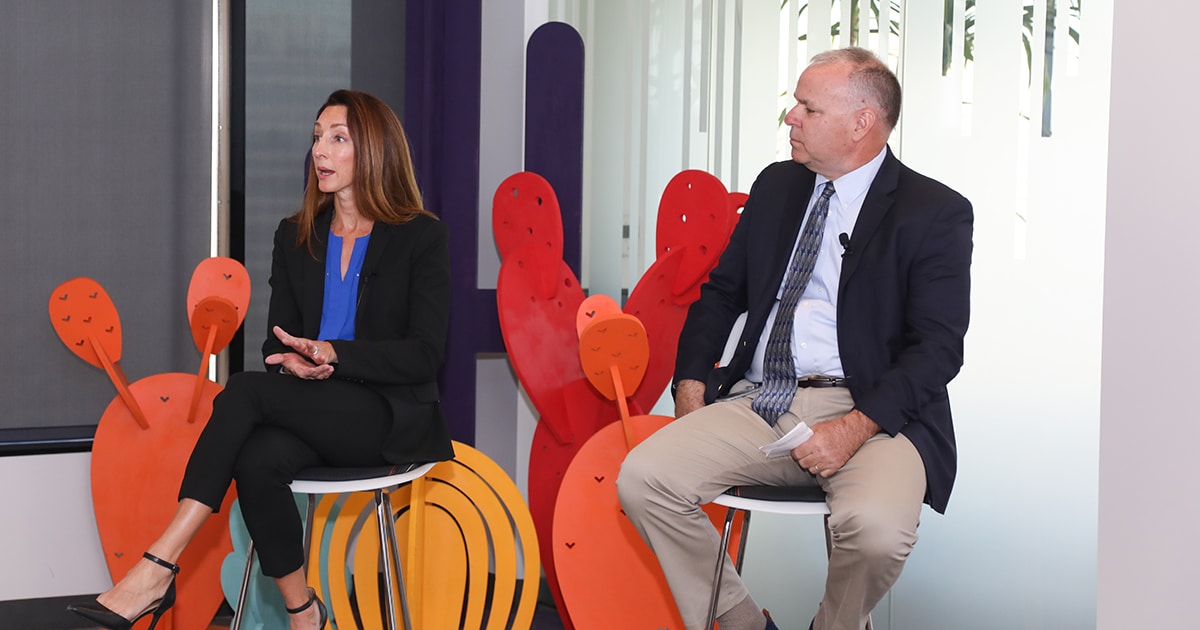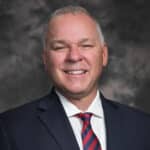

Ambassador Event: The Impact of Prop 400
Published: 10/17/2023
Half-cent sales tax paving the way for innovation, consumer choice in Greater Phoenix
Over the last 40 years, the half-cent sales tax for transportation has helped Greater Phoenix evolve into the metro it is today. The tax revenue has built commuter and travel lines, connected cities, and laid the transportation foundation for businesses to flock into the Valley.
“Prop 400e”, an extension to this tax, was authorized by the legislature and signed by Governor Hobbs in August to be sent to the 2024 ballot for Maricopa County voter approval. Two of the community leaders who worked on the agreement joined a recent Greater Phoenix Economic Council (GPEC) Ambassador Event to discuss the bill, its historical impacts and its proposed plans for the next 20 years. The panel consisted of:
- Jessica Mefford-Miller, CEO, Valley Metro
- Ed Zuercher, Executive Director, Maricopa Association of Governments (MAG)
- Tim Bourcet, Vice President of Corporate Development and Community Engagement, Greater Phoenix Economic Council (GPEC) (Moderator)
“One of our great strengths here in the Valley, and something that we need to preserve, is the strong collaboration and cooperation that we have between our cities and towns, our tribal nations, and Maricopa County itself. We have a long-range transportation plan that was approved by every single Valley mayor, and it included trade-offs in that planning process,” Mefford-Miller said.
“Ensuring that [MAG, Valley Metro, and our cities, towns, counties and Native nations] stay at the table, and we remain there early and often when it comes to making decisions about our infrastructure, is something that we have to preserve. It has been very successful and it’s worth maintaining.”
History of Prop 300 and 400
In 1985, the region’s freeway network consisted of the Interstate 17 and the discontinuous Interstate 10. The US 60 stopped around Country Club Drive, and there was no bus service on Sundays.
Prop 300 changed the transportation network, and with that, changed the way people lived and businesses operated in Maricopa County. The half-cent sales tax funded the construction of most major roadways still in use today: Loop 101 and 202, SR 51, SR 143 and expansions to the I-10, I-17 and US 60. Extended by Maricopa County voters in 2004, the new Prop 400 built the Loop 303, finished the Loop 202 Ed Pastor (South Mountain) freeway, initiated SR 24, built more than 250 miles of new arterial roads, expanded regional bus service and helped establish light rail and streetcar.
The 20-year tax is set to expire in 2025. Led by MAG and comprised of representatives from 27 cities and towns, three Native nations, Maricopa County and parts of Pinal County, a new long-range plan to address new and future transportation needs was supported unanimously with support from the private sector. Unlike all other counties in Arizona, Maricopa County lacks the authority to directly ask its voters to continue the established tax, requiring enabling legislation to be passed by the State House and Senate. HB 2685 was successfully passed by the House and Senate but vetoed by former Gov. Doug Ducey in 2022. At the end of the 2023 legislative session, both chambers passed modified legislation with extensive feedback and testimony from the public and private sector.
On July 31, SB1102 was approved by both chambers and on Aug. 1 signed by Gov. Katie Hobbs to be placed on the 2024 Maricopa County ballot. The extension would support:
- 331 new freeway and highway lane miles
- 134 new HOV network lane miles
- Reconstruction of the I-17
- 25 miles of new bus rapid transit
- Expanded local and commuter bus service
- Capital rehabilitation of the existing light rail system
- Over 1,000 lane miles of new or improved arterial roads
- Expanded investments in technology that facilitates more efficient movement of people and goods throughout the region and responds to future transportation innovations
Among negotiations was the removal of key funds for new light rail extensions; however, it does not prevent local municipalities from continuing existing plans using funding from local and federal sources available to the region.
Analysis of Prop 400e
The economic growth of Greater Phoenix has directly aligned with the investment to the freeway and light rail systems over the last 40 years. A MAG study shows that, between 2000 and 2019, property values proximate to freeways rose more than 200%, while those with proximity to light rail saw property values increase by more than 300%. GPEC metrics show that about 89% of companies the organization has helped expand into Greater Phoenix have chosen a location within two miles of a major transportation corridor since 1989.
The next 20 years will see improvement of existing roads and new routes. This plays a role for cities all around Maricopa County, whether it’s easing access of commuters into Phoenix or the rebuilding of ramps between the Loop 101 and I-10 to bolster access into Tolleson and the southwest Valley for residents and more efficient movement of freight.
This extension notably allows more flexibility than previous plans. Zuercher said that the 2004 bill did not foresee futuristic technology such as autonomous vehicles. The 2024 bill includes a block of funding for emerging technologies.
“We don’t know what’s going to be happening in transportation in five or 10 or 15 years. Some people talk about flying vehicles, some talk about hydrogen, electric. We don’t know, so let’s give ourselves some options in the next 10 years to be able to respond,” Zuercher said.
Perhaps most importantly, this increases mobility for millions of people, whether people are driving or using public transportation. Mefford-Miller said there are 32 million bus and rail riders each year, and a third of the system’s users do not have access to a car.
“[Investments in transit] levels the playing field and it creates access to opportunity and freedom of mobility,” Mefford-Miller said. “As we think about involving everyone in our communities, in education opportunities and in the workforce, having public transit there is absolutely essential.”
The increase of mobility options is at the core of Prop 400e. Whether residents want to take public transportation or continue driving their choice of vehicle on modernized roads, this half-cent sales tax has paved the way for consumers to choose their own path.
“The key to it is choices for people to live the kind of life they want to live, where they would like to live, in a place they would like to live — and transportation has to support that,” Zuercher said.
Meet the Panel
Jessica Mefford-Miller
CEO
Valley Metro
Ed Zuercher
Executive Director
Maricopa Association of Governments
Tim Bourcet (Moderator)
VP, Corporate Development & Community Engagement
Greater Phoenix Economic Council


